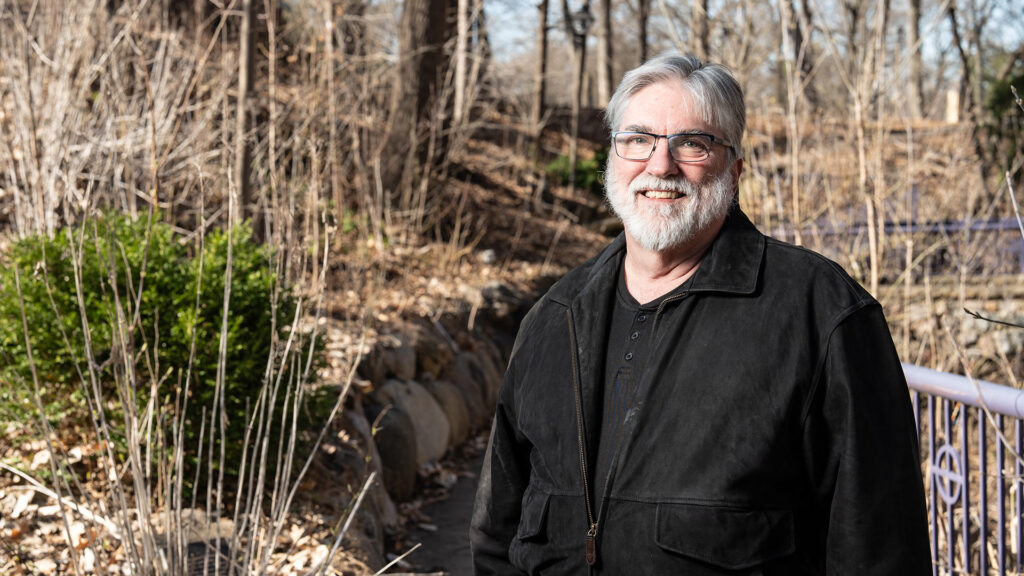Xcel Energy President (MN, ND, SD) Ryan Long discussed energy challenges and innovation at the University of St. Thomas Finding Forward event on April 10.
The electricity used in every home and business is the same. But how that electricity is generated has stirred impassioned divisions for generations. Nuclear power, fossil fuels and renewable energy sources, and their related environmental and political movements, all have advocates and detractors, battled over everywhere from boardrooms to legislatures to social media feeds.
Ryan Long, the president of Xcel Energy’s operating company in Minnesota, North Dakota and South Dakota is deeply aware of the balancing act he needs to pull off.
At a recent Finding Forward session at the University of St. Thomas, Long offered a look at Xcel’s plans and progress, calibrated to try and achieve an ambitious transition while minimizing the risks to communities and customers.
“What do we need to build?” Long asked. “What do we need to put onto our system to ensure that we’re going to reliably and safely serve our customers? We’re balancing four objectives: cost, risk, environmental concerns, and reliability.”

The carbon-free challenge: ensuring reliability and affordability among uncertainty
Opening conversations between people with different perspectives can be challenging but is vitally important when facing far-reaching issues. The Finding Forward series is one way the University of St. Thomas seeks to model and enable productive engagement around thorny topics.
“I think that energy issues and the energy transition fits so nicely within the framework of Finding Forward,” said Long. “Not only do different parties in different states take really different views, we are still finding our way forward to our ultimate goal of getting to 100% carbon-free energy.”
Xcel is keenly aware of the challenges. As a regulated business, the rates Xcel charges customers and decisions to build or shut down power plants require approval from government agencies. The politics of the places it operates puts limits and guidelines around the company’s actions. For example, a law passed in 2023 says Minnesota’s electricity must be carbon free by 2040 – ten years earlier than Xcel had planned for.
Xcel has been committed to moving away from fossil fuels for decades. Fossil fuels emit greenhouse gases that contribute to climate change and pollution that can impact health. However, fossil fuels are comparatively inexpensive, very reliable, and many power plants are designed to use them.
There’s also a need to manage unpredictability in this transition, warned Dr. Mahmoud Kabalan, associate professor of electrical engineering and the founding director of the Center for Microgrid Research at the University of St. Thomas.
“A lot of assumptions are really not accurate anymore,” Kabalan said. “Germany decided to retire nuclear (power) first and then bridge the gap with (Russian) natural gas. When the Ukraine war happened, the natural gas went away and Germany actually reverted back to coal.”
Nuclear, wind, solar, gas, batteries, hydrogen: the elements of Xcel’s plan
“We really are kind of ‘all options on the table’ and whatever solves the problem in the most economic, safe and reliable way is what we want to adopt,” Long said.
The plan Long laid out will still be controversial to different groups for different reasons. It starts with shutting down Xcel’s remaining coal-burning plants by 2030. Simultaneously, Xcel is building a huge solar facility on land around one closing coal plant, tapping into existing power lines and also helping the community by providing jobs and economic activity. New wind turbines throughout the region will also add to carbon-free capacity.
The company is experimenting with new Form batteries built alongside the new solar field. These batteries use iron oxidation to store and then release huge amounts of energy and can deliver power for 100 hours, keeping the grid up when the wind doesn’t blow and sun doesn’t shine.
To backstop even the batteries, new natural-gas burning turbines to cover peak demand are planned. This will add new fossil fuel generation but will overall reduce emissions and someday the same turbines can be fueled by carbon-free hydrogen. Xcel is investing in hydrogen-generating facilities to hopefully replace natural gas over time.
Finally, Xcel is talking to the state about keeping its three nuclear reactors in Minnesota active into the 2050s. Nuclear power is controversial in its own right but is carbon-free and reliable.
These new technologies require new skills and ways of thinking. “We want to redefine what is possible on the engineering education side,” said Kabalan. “I think the energy transition requires us educators to think differently about how we produce engineering students (who) are ready to hit the ground running.”
Reaching across ideological divides, rethinking the grid
In a time of transition, there is an opportunity to rethink how the system works. Kabalan is researching an approach called a microgrid, in which community-based local generation (ideally renewable) links into the grid from the “end,” supplying local residents first and then adding surplus to the grid or covering shortfalls by drawing from it. Under Kabalan, the University of St. Thomas has deployed a pilot microgrid on campus and aims to scale it up in coming years.
Long sees promise in new modular nuclear reactors which use molten salt and are safer and smaller than today’s reactors. “We’re still a ways off from that being commercially available, but we’re paying a lot of attention.”
Long hopes Xcel’s track record offers some reassurance: Already, wind and solar make up more of its generation than coal and gas. Altogether, 67% of Xcel’s power in Minnesota and the Dakotas is carbon free, including 24% generated by nuclear.
The emphasis now is on execution. Long said that with the recent major coal plant decommissioning, he sees Xcel’s energy transformation as well underway.
To Kabalan, it can’t come soon enough. “We’re at a point with our climate change trajectory that we need to act now. There’s a lot of really promising technologies … We just can’t wait.”
Finding Forward’s next event will be held on May 30

Finding Forward welcomes certified performance consultant and author of Beyond Grit, Cindra Kamphoff, PhD, for an event dedicated to mental health and resilience. Kamphoff works with elite athletes to improve their mental game, and she’ll be joined in conversation by University of St. Thomas psychology professor and men’s basketball head coach, Johnny Tauer, PhD.
Following Kamphoff’s keynote address, the discussion with coach Tauer will be moderated by Star Tribune Senior Assistant Sports Editor and President of the Associated Press Sports Editors, Naila-Jean Meyers.









